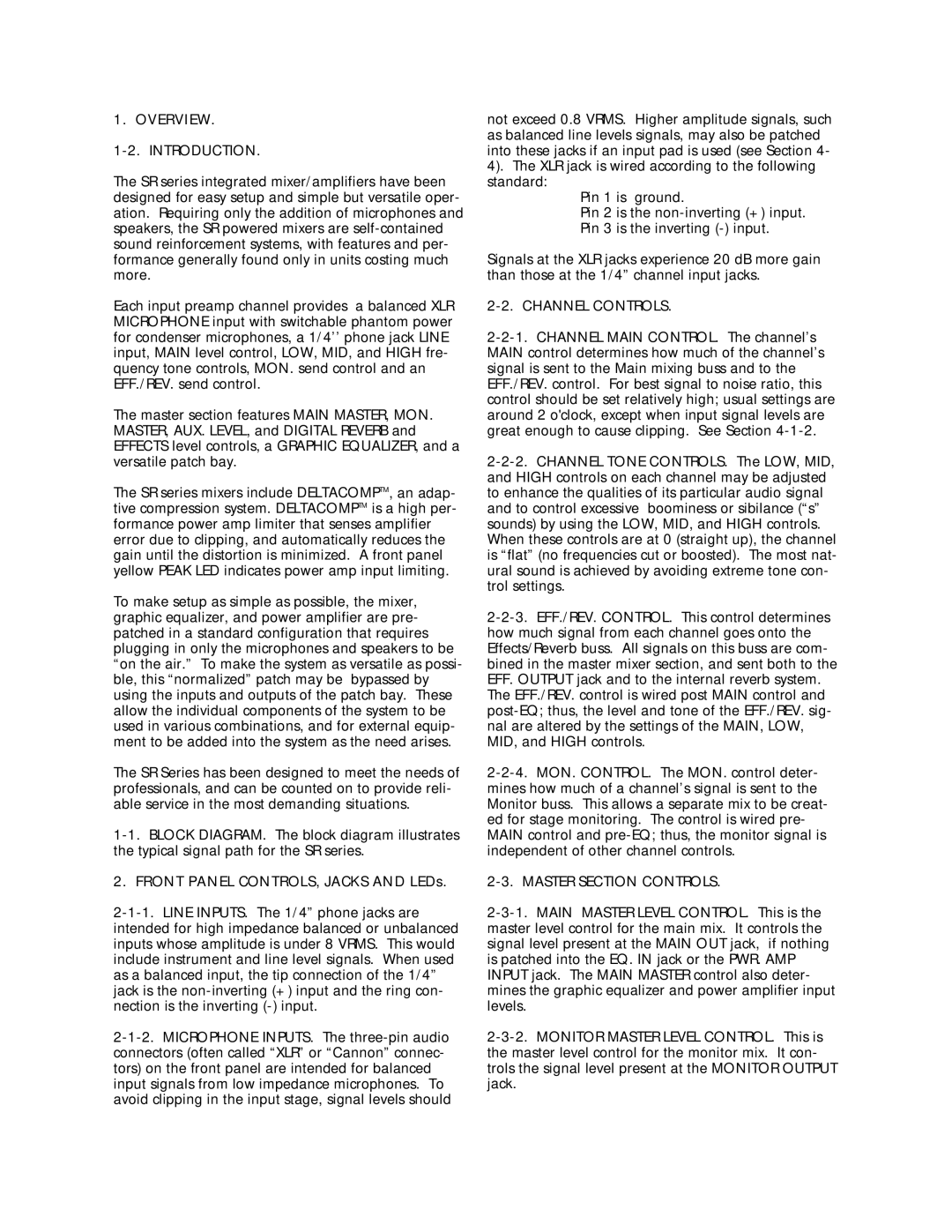1. OVERVIEW.
1-2. INTRODUCTION.
The SR series integrated mixer/amplifiers have been designed for easy setup and simple but versatile oper- ation. Requiring only the addition of microphones and speakers, the SR powered mixers are self-contained sound reinforcement systems, with features and per- formance generally found only in units costing much more.
Each input preamp channel provides a balanced XLR MICROPHONE input with switchable phantom power for condenser microphones, a 1/4’’ phone jack LINE input, MAIN level control, LOW, MID, and HIGH fre- quency tone controls, MON. send control and an EFF./REV. send control.
The master section features MAIN MASTER, MON. MASTER, AUX. LEVEL, and DIGITAL REVERB and EFFECTS level controls, a GRAPHIC EQUALIZER, and a versatile patch bay.
The SR series mixers include DELTACOMPTM, an adap- tive compression system. DELTACOMPTM is a high per- formance power amp limiter that senses amplifier error due to clipping, and automatically reduces the gain until the distortion is minimized. A front panel yellow PEAK LED indicates power amp input limiting.
To make setup as simple as possible, the mixer, graphic equalizer, and power amplifier are pre- patched in a standard configuration that requires plugging in only the microphones and speakers to be “on the air.” To make the system as versatile as possi- ble, this “normalized” patch may be bypassed by using the inputs and outputs of the patch bay. These allow the individual components of the system to be used in various combinations, and for external equip- ment to be added into the system as the need arises.
The SR Series has been designed to meet the needs of professionals, and can be counted on to provide reli- able service in the most demanding situations.
1-1. BLOCK DIAGRAM. The block diagram illustrates the typical signal path for the SR series.
2. FRONT PANEL CONTROLS, JACKS AND LEDs.
2-1-1. LINE INPUTS. The 1/4” phone jacks are intended for high impedance balanced or unbalanced inputs whose amplitude is under 8 VRMS. This would include instrument and line level signals. When used as a balanced input, the tip connection of the 1/4” jack is the non-inverting (+) input and the ring con- nection is the inverting (-) input.
2-1-2. MICROPHONE INPUTS. The three-pin audio connectors (often called “XLR” or “Cannon” connec- tors) on the front panel are intended for balanced input signals from low impedance microphones. To avoid clipping in the input stage, signal levels should
not exceed 0.8 VRMS. Higher amplitude signals, such as balanced line levels signals, may also be patched into these jacks if an input pad is used (see Section 4- 4). The XLR jack is wired according to the following standard:
Pin 1 is ground.
Pin 2 is the non-inverting (+) input. Pin 3 is the inverting (-) input.
Signals at the XLR jacks experience 20 dB more gain than those at the 1/4” channel input jacks.
2-2. CHANNEL CONTROLS.
2-2-1. CHANNEL MAIN CONTROL. The channel’s MAIN control determines how much of the channel’s signal is sent to the Main mixing buss and to the EFF./REV. control. For best signal to noise ratio, this control should be set relatively high; usual settings are around 2 o'clock, except when input signal levels are great enough to cause clipping. See Section 4-1-2.
2-2-2. CHANNEL TONE CONTROLS. The LOW, MID, and HIGH controls on each channel may be adjusted to enhance the qualities of its particular audio signal and to control excessive boominess or sibilance (“s” sounds) by using the LOW, MID, and HIGH controls. When these controls are at 0 (straight up), the channel is “flat” (no frequencies cut or boosted). The most nat- ural sound is achieved by avoiding extreme tone con- trol settings.
2-2-3. EFF./REV. CONTROL. This control determines how much signal from each channel goes onto the Effects/Reverb buss. All signals on this buss are com- bined in the master mixer section, and sent both to the EFF. OUTPUT jack and to the internal reverb system. The EFF./REV. control is wired post MAIN control and post-EQ; thus, the level and tone of the EFF./REV. sig- nal are altered by the settings of the MAIN, LOW, MID, and HIGH controls.
2-2-4. MON. CONTROL. The MON. control deter- mines how much of a channel’s signal is sent to the Monitor buss. This allows a separate mix to be creat- ed for stage monitoring. The control is wired pre- MAIN control and pre-EQ; thus, the monitor signal is independent of other channel controls.
2-3. MASTER SECTION CONTROLS.
2-3-1. MAIN MASTER LEVEL CONTROL. This is the master level control for the main mix. It controls the signal level present at the MAIN OUT jack, if nothing is patched into the EQ. IN jack or the PWR. AMP INPUT jack. The MAIN MASTER control also deter- mines the graphic equalizer and power amplifier input levels.
2-3-2. MONITOR MASTER LEVEL CONTROL. This is the master level control for the monitor mix. It con- trols the signal level present at the MONITOR OUTPUT jack.
